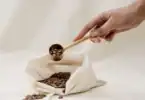I am a huge fan of Maldon Salt, but sometimes I get asked about what other salts make good Maldon Salt alternatives. There may be a number of reasons – price, availability, variety, or other criteria that get people wondering what kinds of salt are most similar to Maldon.
If you are not yet familiar with this terrific finishing salt, be sure to read our article Maldon Salt: A Reason to Flake Out!
What is Maldon Salt?
Maldon Salt is a naturally evaporated Sea Salt that was originally found occurring in nature in Maldon, England a very long time ago. At first it was just gathered up and used as a trade good – salt was worth a lot back then! In 1882 the Maldon Salt company was formed, and they started coming up with methods to produce this uniquely crystallized salt to meet with demand. This salt is famous enough that it even has it’s own Wikipedia Page.

Maldon salt itself is extremely flaky, with large and soft pieces. Larger pieces show a distinct pyramid shape as you can see in the lower left of my picture.
This salt is usually used as a finishing salt. In other words, most people use it when serving food and the crystals are sprinkled on top, usually by pinching and crushing them between your fingers. I suppose some people also cook or prepare food with Maldon salt, but the unique texture and flavor shines when used as a final flavor adjustment on meats, eggs, veggies, salads and more.
For more information about sea salt vs. sea salt flakes, I’d refer you to this article: Sea Salt vs. Sea Salt Flakes: Understanding The Differences.
Salts That Can Serve as Maldon Salt Alternatives
There may be a variety of reasons that you are searching out a Maldon salt substitute. In this section I will try to anticipate some of the reasons to be able to offer you some good Maldon salt alternatives.
Product Availability
Sometimes folks just want to be able to pick up something at their local store while shopping for other stuff. Products like Maldon salt and Maldon salt substitutes tend to only get carried at higher end markets or at food specialty stores. That being said, maybe you’ve seen products that look similar and would like to know more about them before spending “a chunk ‘o change” on them.
Of all the flaky sea salt choices that I know of in the world of salt, I think that Fleur de Sel is the closest replacement for Maldon salt. Fleur de Sel of course, means “flower of salt” in French, and it is sometimes called Flor da Sal when produced in Spanish speaking countries. Fleur de Sel is produced by collecting the thin layer of salt that rises to the top of shallow salt pans near the ocean. The original location for this was France, but similar operations now produce a similar type of flaky salt in many areas around the globe.
To give you an example, I’ve picked out one of my favorite Fleur de Sel products to link. This one has fairly good distribution, so it may be the one you see at your local gourmet food supplier.
Delightful salt that is naturally harvested by hand from the very top layer of French salt pans on the Île de Ré off the coast of France. This is a 5.6 ounce jar, but it lasts me a very long time (months) because you don't need to use much to achieve a lovely salty finish on foods.
Maldon Salt Alternatives from the United States
Worried about tariffs? Aren’t we all? But the chance of huge price increases on Maldon salt due to possible tariffs on products from the UK made me start thinking about what my domestic alternatives are.
One company that has very nice products is the Jacobsen Salt Co. from Oregon.

You might need to zoom in to see it, but these sea salt flakes from Netarta Bay, Oregon are very light and fluffy – making it a possible replacement for Maldon salt. I found this package at my local wine merchant, that has a nice gourmet food section in the store.
I attempted to find an online link for this salt so you can check it out, but the only products I could find were flavored (nice, but not a direct comparison) and one VERY LARGE container (instead of the nice 4 ounce package in my hand). I did find this combination package that might be of interest, though. It has the same salt as the picture above, plus their kosher salt and a jar of flavored salt.
This package contains a 4 ounce bag of flaky sea salt (which takes on a pyramid shape in the larger pieces), a 3/4 pound drum of kosher sea salt, and a 4.23 ounce jar of Black Pepper salt. All of the salt in the products are from the United States.
On the other coast, I found a woman owned Sea Salt company in Florida that is harvesting salt from the Atlantic ocean. The name of the company is Florida Pure, and they tout their salt as having 80+ trace minerals. A 1/4 teaspoon of this salt contains 380mg of sodium, so this factor and the coarsely grained rather than flaky appearance is similar to a kosher sea salt. If you want to know more about sodium content in a variety of salt (from dense to flaky), be sure to read our article Salt Comparison Guide: Salt Sodium Content.
This is a small jar of hand harvested Florida Pure sea salt - 1.75 ounces, with a cute bamboo lid. Even once the salt is used up, I predict that the jar and lid might make a good storage container for other salt. This company is woman owned and United States based.
Maldon Salt Alternatives from North America
Maybe the tariffs with Mexico will be lower than those affecting the UK or Europe. Perhaps you want some ideas for brands to look for on your next Mexican beach vacation. In any case, there are two flaky finishing salts that “rise to the top” for me that are both produced in Mexico.
Baja Gold is one of the better known salt companies selling Mexico sourced sea salt. Their ‘natural grain’ variety has 450mg of sodium per 1/4 teaspoon, so you will find it more dense than some of the other Maldon salt alternatives, and Maldon salt itself, which comes in at 280mg of sodium per 1/4 teaspoon (due to ultra-flaky, non-dense crystal structure). Baja Gold is a tasty finishing salt with many trace minerals – I like placing this kind of salt in a ceramic grinder so that I can spread the salt bits evenly and increase the surface area of each grain. You’ll also note that this is one of the most economical salts listed on this page going by price per ounce.
This bag of naturally harvested sea salt from the Sea of Cortez. Trace minerals include Calcium, Potassium and Magnesium. This 16 ounce bag contains 'medium grained' salt.
There are quite a few Mexican salt products that are identified with the name Colima. Colima (the city) is about 50 km from the Pacific coast, so I think it is also used as a regional identifier. There are some really nice naturally harvested salt products from this area so it was hard to choose just one.
I think you’ll really like this salt! The price point is very similar to the Baja Gold, but the salt itself is a very close replacement for Maldon salt in both sodium content (250mg per 1/4 teaspoon) and in crystal structure (be sure to use the zoom feature to look at the salt in the bag: I see pyramids!).
Kolimo is a salt brand from Colima Mexico - and this package of 8 ounces of salt is their version of Fleur de Sel - a fluffy light finishing salt.
No Iodine Here
One of the other ways that all of the salts mentioned on this page are similar to Maldon salt is that none of them is a significant source of dietary Iodine. If you are concerned about Iodine, I would direct you to this article: Details On Iodine In Himalayan Salt: What You Need To Know. While this article focuses on Himalayan Pink salt, the non-iodine containing nature of it is the same as these naturally harvested sea salts.
Final Thoughts
Whatever your reason for seeking out Maldon salt alternatives, I hope that the ideas on this page will lead you to what you are looking for! One reason I didn’t go into was simply VARIETY. I love trying out different unique salts, especially those designed for finishing. It’s a wonderful way to put a flavorful ‘pop’ into your food!












